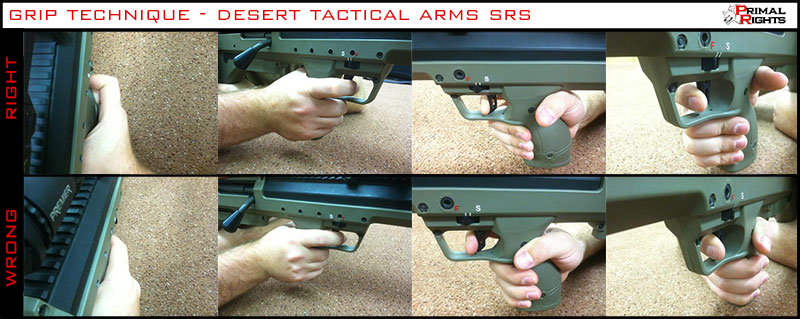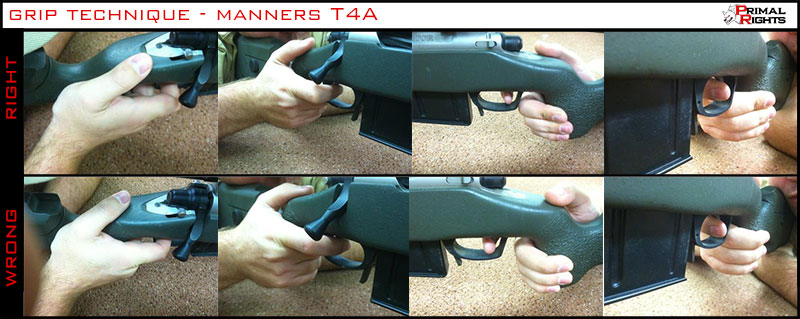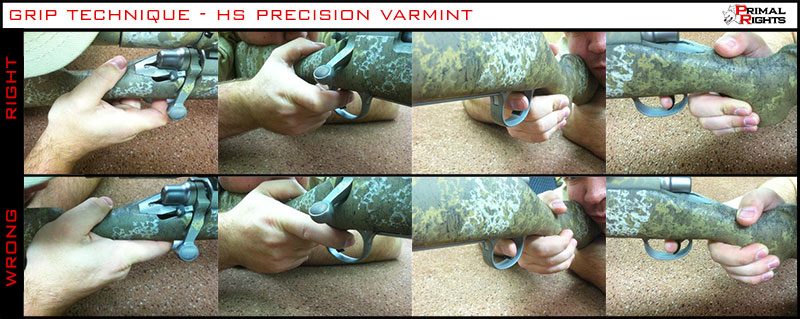![]() Phone: 605-554-1911 | Email : sales@primalrights.com
Phone: 605-554-1911 | Email : sales@primalrights.com
Precision Rifle Marksmanship - Grip Technique
Jan 23, 2013Written By - Greg Dykstra
© Copyright 2009 - Present - Primal Rights Inc
ALL RIGHTS RESERVED
No part of this website or any of its content may be reproduced, distributed, or transmitted in any form or by any means without the express prior written permission of Primal Rights, Inc
No matter your rifle, sighting method, firing position, or distance to target; Grip technique is one of the most important aspects of operating a precision rifle effectively. As an instructor and as a shooter, I have seen just about every kind of grip imaginable. Of all the precision rifle fundamentals, grip is the least talked about and least practiced skillset of them all. Obviously there are other more important fundamentals such as body position, crosshair control, optical alignment, breathing, and trigger press. However, having a proper grip can determine how consistently you are able to do some of the above listed fundamentals. Operating a rifle correctly requires the sum of its parts in order for the end result to be as good as it can be. All of the fundamentals need to be present and executed flawlessly in order for each shot fired from your rifle to be of any value. Today, we're going to take a look at proper rifle grip being applied to different stock configurations, as well as how not to do it.
For the purposes of this article, we aren't going to talk much about trigger manipulation. This is a separate fundamental all it's own that will be the topic of a future article. What we are going to address is how the hand should be positioned on the stock so that you will be able to manipulate the trigger properly. Also, please keep in mind that many of the techniques described in this article aren't revolutionary or ground breaking in any way. Most of them have been developed over the last couple hundred years by various pioneers in shooting sports. So I'm not taking credit for any of this. I'm simply trying to break down the technique to its core components and explain it in a way that is easily digestible.
Your firing hand being identified as your dominant hand that will be in charge of gripping the rifle, pressing the trigger, and operating the bolt is what we're going to focus on. This is the hand that has the most influence on the fire control mechanisms of the rifle. Obviously your non-firing hand will either be offering support to the rear of the rifle directly, manipulating a rear bag, or supporting the rifle in some other method such as a tripod or shooting bag.
Your firing hand should not be supporting the weight of the rifle at all. This burden should be placed on whatever you are using to support the rifle. While holding the grip, your firing hand should not be putting pressure up, down, left, or to the right. You should be able to remove your firing hand from the rifle while in your firing position, and not disrupt your crosshairs alignment with the target. If you remove your firing hand, and your cross hair moves, then it is likely that you are imparting force one way or another on the rifle with that hand. This is somewhat dependent upon how firm of a position you are in. If you are high on a rear bag, the addition of your firing hand may cause the bag to settle a bit, so don't be alarmed. This isn't optimal, but expected, and can be accounted for. The idea being that whatever you are using to support the rifle, is also supporting the weight of your firing hand while it's attached to the grip. The savvy among you have by now also realized that you don't want to add weight to the rifle with your firing hand, as it can disrupt your position. It is important to understand the distinction however. One of the rules as it pertains to excellent form is that you don't want to use muscle power to stay on target. If you are muscling the rifle, your first shot will suffer and so will your follow-up shots. Think of your hand as an attachment point. All you are doing is attaching it to the rifle at a fixed position in a specific manner. So, attach your hand to the rifle, but do not apply pressure in any direction yet. We'll get to that later. Simply attach, and let your arm come to rest, maintaining just enough force to engage the rifle firmly. The manner in which you set up your "attachment point" on the rifle does not vary that much between stock designs. The fundamentals of the good grip are always present, regardless of the type of rifle you are shooting. So rub the idea that this stuff doesn't apply to your rifle right out of your head. Now we are going to discuss precisely how to setup your attachment point (hand) to properly interface the stock and fire control mechanism on your rifle.
Illustrating each individual fundamental is very difficult due to the fact that a proper grip is a function of many things happening in harmony simultaneously. The whole is greater than the sum of its parts. So we'll get the reading out of the way, and then show you some pretty pictures of the right way and wrong way to interface a couple popular stocks later.
Grip Fundamental #1 - Trigger Finger
Your engagement with the trigger is the most important part of your grip. Unless you can feel exactly what the trigger is doing at all times, you won't really be able to control when and where the rifle fires. The easiest way to accomplish this is to isolate the trigger finger completely. Apply the last pad on your index finger to the center of the trigger shoe. Make sure that the trigger shoe is resting in the middle of the pad on your finger. You do not want it out at the tip, nor do you want it in toward the first finger joint. Next, you will bend the second joint in your index finger to form a 90 degree angle toward you, while keeping the first joint straight. This is going to feel completely mutated the first few times you do it. You'll want to ensure that your trigger finger isn't contacting any part of the rifle when it is seated on the trigger shoe. The goal here is to completely isolate the action of pressing the trigger. The motion should be straight back to the rear, without imparting any pressure up, down, or to the sides. Bending the second joint at a 90 degree angle facilitates this motion. The next order of business is to attach the rest of your hand to the rifle in the exact location on the stock that doesn't disrupt the trigger finger position which you've just identified. You'll most likely immediately notice that your hand is way too far forward to get a firm grasp on the stock like you are used to. Don't panic, this is quite alright. Job number one of isolating the trigger finger has been accomplished!
Grip Fundamental #2 - Finger Position
Obviously the new method in which you are engaging the trigger with your newly developed 90-degree finger probably feels a bit like trying to shove a square peg through a round hole. Sometimes it will take a great deal of practice in order to get your finger to function that way at all. It's not normal to bend that second joint without also bending the first. This is to be expected, we're fighting against thousands of years of natural instincts that say when something is in your hand you are suppose to grab hold of it completely. Your trigger finger is doing its job correctly now, so all the rest of your fingers should be tasked with is keeping your trigger finger in that specific position. We already established that you shouldn't be driving or supporting the rifle with this hand, so don't try. Instead, just lay your fingers down against the stock in the position they are in, by bending the second joint on all those fingers. Just as with the trigger finger, this should almost create a 90 degree angle. The exact angle will be determined by the style of stock you are using, and isn't important. What IS important is that you aren't clenching the stock. Your fingers should make contact, and you should apply enough pressure so that your trigger finger is locked in place. It's not a squeeze, but more of a "clamp."
Grip Fundamental #3 - Thumb Position
Where you put your thumb is of little concern. You can lay it on the side or top of the stock. You can put it through a thumb hole. You can wrap it around a pistol grip, or fly out out in open space. It really doesn't matter. What does matter is that you avoid imparting any directional pressure on the stock with your thumb. You don't want to assist in pressing the trigger with your thumb either. Some old wisdom states that you want to squeeze your whole hand, rather than just isolate your trigger finger. Don't listen! You must allow your trigger finger to do its job. That is the only way you can truly be in tune with your trigger. Again, the specifics of how to manipulate the trigger will be talked about in a later article, but suffice it to say that you want absolutely nothing else getting in the way when pressing that trigger shoe straight rearward. To that end, your thumb can either be laid idly on the stock to assist with the "clamp" of your other fingers in the case of a a Manners MCS-T4A or propped up against the underside of the stock with a thumb-hole or tactical style stock such as the DTA shown in the images below. In any event, do NOT put impart any force up, down, left, or right into the stock.
Grip Fundamental #4 - Rearward Pressure
Many old timers will be a huge advocate of pulling the rifle back into your shoulder firmly. Some say very firmly, while others simply say with enough pressure to feel it. I say, don't pull it into you at all. Your firing hand has enough to worry about with having to manipulate the trigger, work the bolt, and deal with the safety. Instead of pulling the rifle back into you, why not use the dead weight of your body to lay into it? Obviously this is entirely situational, since the amount of pressure brought to bear will vary depending on your firing position. If you are shooting down a steep hill, or firing down the side of a building as a police sniper, you damn well better be pulling the rifle back toward you or else it will run away! It is then important to make sure you are applying that pressure straight toward the rear and not off to either side. This can be pretty difficult to do effectively until you've mastered the grip itself. A lot of this particular fundamental carries over into another forthcoming article on body position, so we'll stop there.
Here's a few images that show good and bad grip technique on three different stock types. The right way is on top, with the wrong way on the bottom. You'll have to click on them to make them larger.
As you can plainly see by the above images, some stocks will lend themselves to proper grip technique a lot better than others. Do you see anything when comparing the proper grip on the HS Precision stock vs the Manners and DTA stocks? Notice the vertical orientation of the trigger finger on the HS stock. It is pointing downward at a very steep angle in relation to the barrel compared to both the manners and the DTA. This indicates that in order to have any grip at all on that stock, I can not press that trigger straight to the rear of the rifle. The way my hand is oriented, I have no choice but to be pressing slightly upward as well. The only way to counter this would be to slide my hand downward, which would result in at least 2 of my fingers no longer being in contact with the stock at all. You can already see that there is a huge void between my palm and the stock as it is. When the grip is broken down to its core components, and illustrated in this fashion, you can plainly see the glaring deficiencies of the traditional-style stocks as it pertains to proper grip technique.
Along those lines, you can very plainly see that DTA has done their homework. The DTA chassis is the closest that I've ever felt in terms of perfection in regard to assisting the shooter achieve proper grip technique. This is demonstrated by the fact that it's kind of hard to grip at DTA improperly! As I've often said, it is not an accident that I rarely shoot anything but a DTA these days, and that was the case long before we became a dealer for them. For those of you that like the more traditional rifles, you can see that the Manners T-series stocks are a great choice. They have a large palm swell, and a more vertical grip that is pushed forward a bit to accommodate good technique.
So now that I've introduced you to some important grip technique fundamentals, how many of you are re-thinking your next stock purchase?




